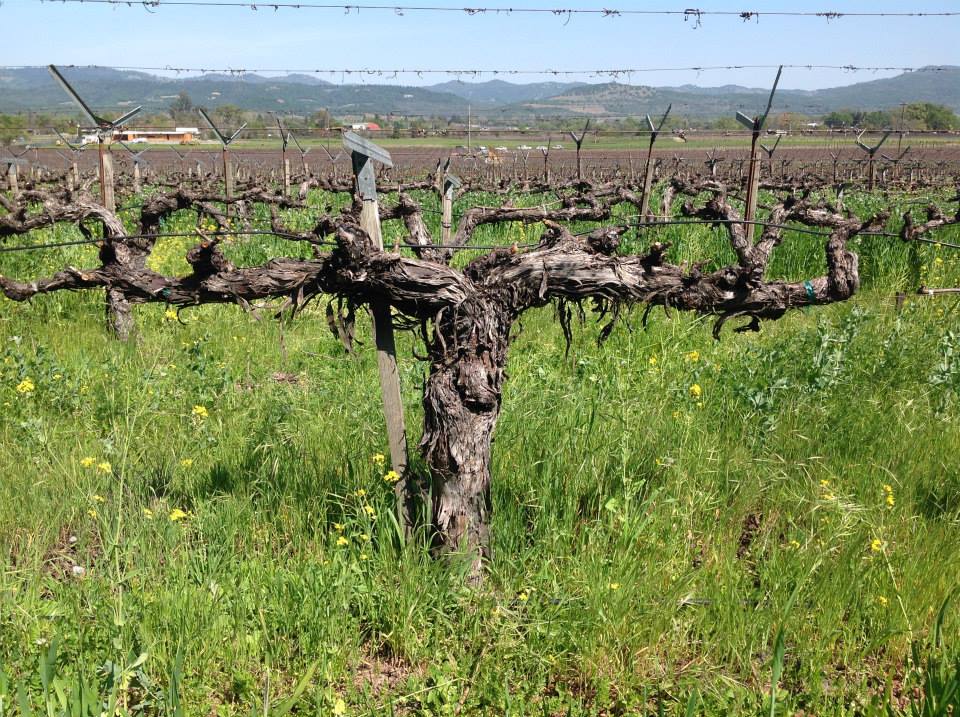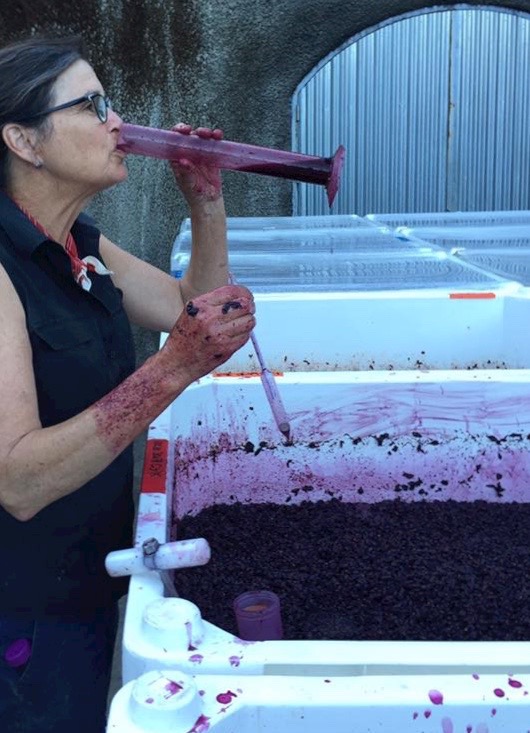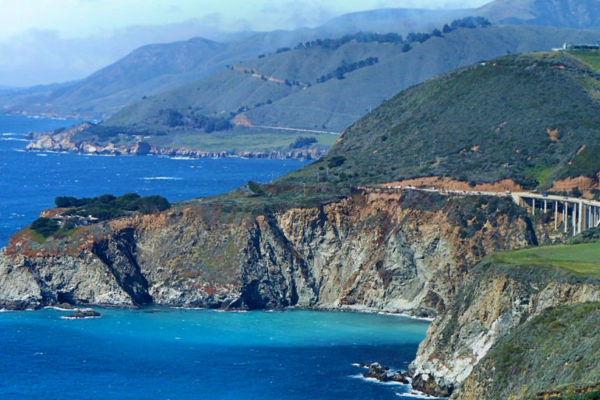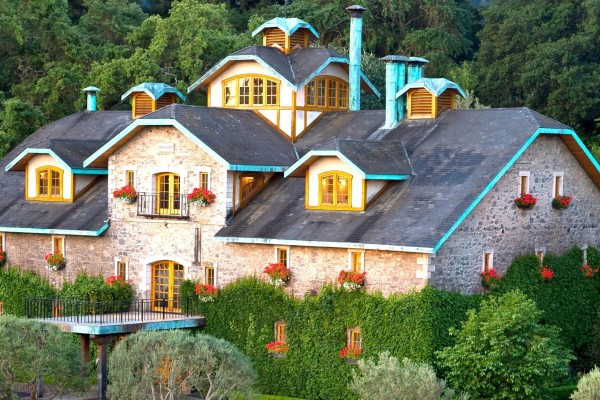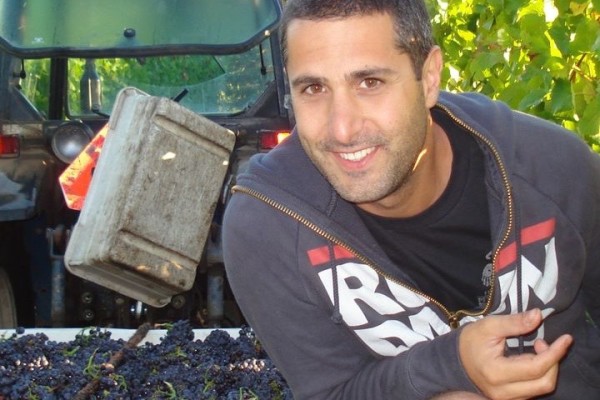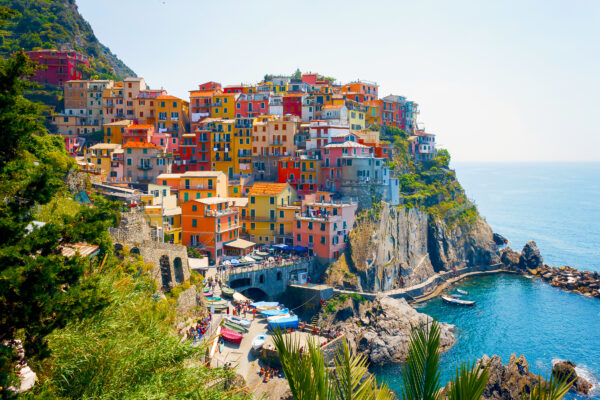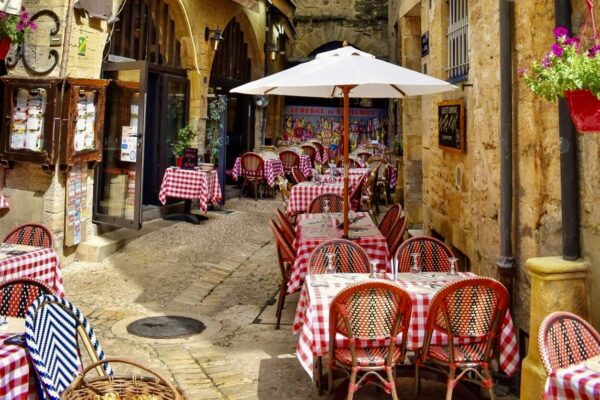Tres Sabores Wines: 3 Fingers Way up!
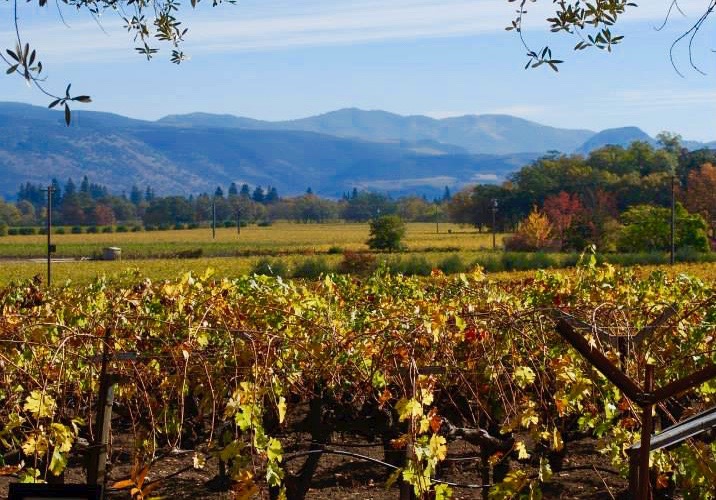
Tres Sabores, on the western Rutherford Benchland of California’s Napa Valley, grows organically certified Zinfandel, Cabernet, Petite Sirah and Petit Verdot grapes, olives, Meyer lemons and exotic pomegranates. Photo courtesy of Tres Sabores.
a conversation with Julie Johnson of Tres Sabores Winery
by Michel Thibault, owner of Michel Thibault Wine and Vice President and Director of Sales for Wine World
One of the standout winemakers in Napa is Julie Johnson. Her Tres Sabores Winery (meaning “Three Flavors” in Spanish) is known for its diversified products, not only grapes, but olives, Meyer lemons and pomegranates – all grown by means of biodynamic techniques. I’m personally fascinated with her winemaking style. She loves to push the envelope – for example her use of wild yeast is somewhat unorthodox, but the end result is beautifully crafted, successful wine.
I had a chance to chat with Julie at a recent wine tasting and learn more about her vision for Tres Sabores.
What are the most noticeable changes in the wine since you went into biodynamic work?
While our Tres Sabores property (vineyards as well as olives, pomegranates and lemons) was one of the first in the northern CA region to be certified organically grown through CCOF (California Certified Organic Farmers), we are not certified biodynamic – that is the mark of the Demeter Association.
The two organizations are not mutually exclusive, although you do not have to go through the three year, 3rd-party organic certification process to enroll in the seven year Demeter certification process. Organic certification is fairly simple: a farmer only uses registered, non-synthetic materials on her land.
The U.S. makes it more complicated because unlike Europe, the U.S. (USDA) has two organic certifications — one for growing organically (which I have) and a second for producing wine organically without sulfite addition (which is allowed under the European organic certification method if one keeps the total sulfite content under 100 ppm).
While I believe in a great deal of the Biodynamic philosophy, as originally championed by Rudolf Steiner, especially when it comes to recognizing the spirituality of the land and investing in the dynamic process that creates not only healthy soil but a wonderfully rewarding atmosphere for the practice of farming, I find that my perennial crops do better tuned into our microclimate’s specific needs.
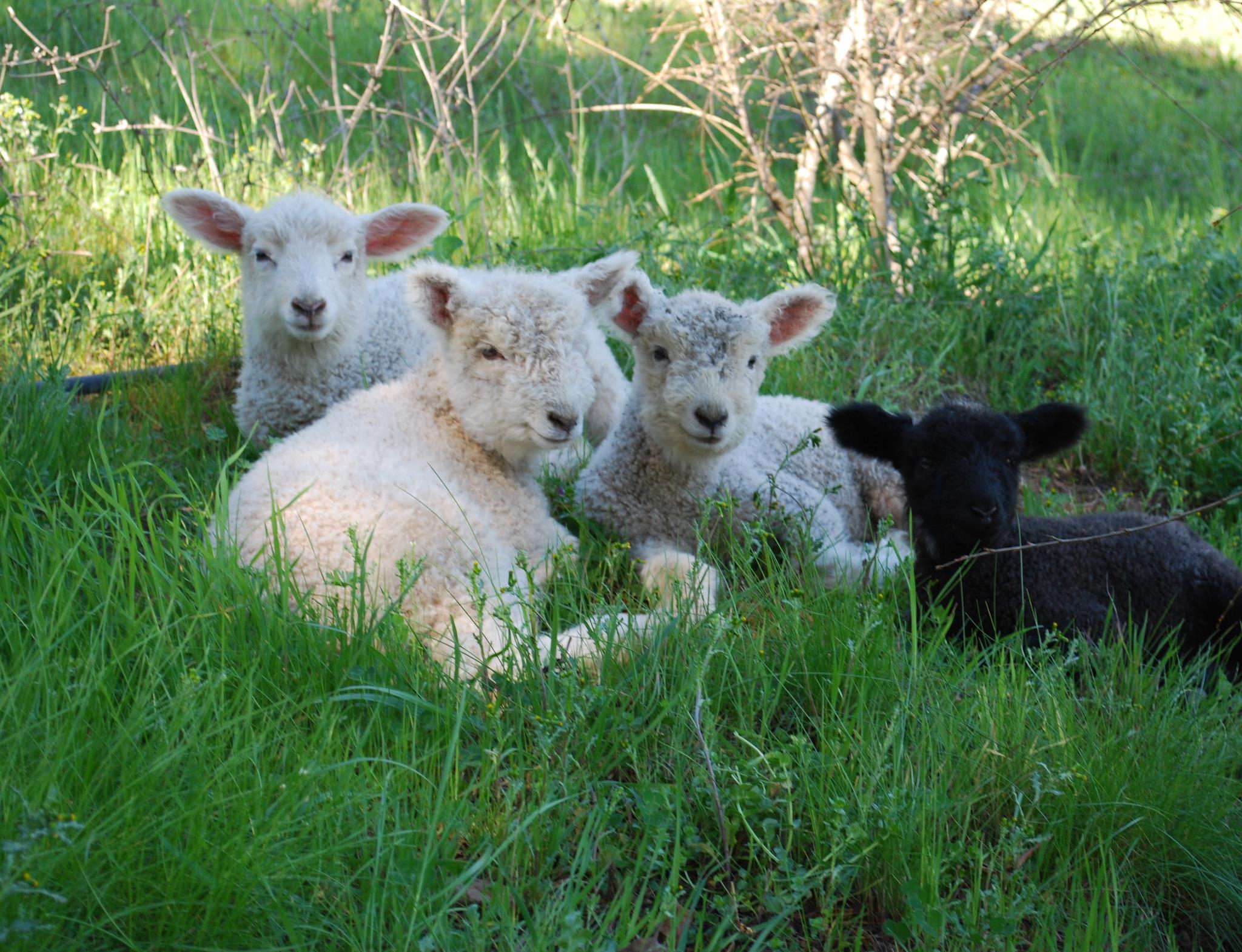
Biodynamic Tres Sabores employs sheep and guinea fowl to make compost, serve as cover crop mowers and entertainers – also essential! Photo courtesy of Tres Sabores.
So, for example, we employ sheep and guinea fowl on our farm (instead of cows) to help make our compost, serve as cover crop mowers and entertainers. We largely farm without irrigation (dry farm) so our emphasis is on keeping the rhizosomal biosphere in our soils as healthy and diverse as possible. Dry farmed vines send their roots deep into the soil—sometimes as deep as 20-30 feet so we do everything we can to nourish the soil. Healthy soil means high quality grapes.
Are some of these changes not necessarily positive? What in terms of quantity of workload change has it meant for you?
We’ve always farmed organically, because we live on our ranch and didn’t want our children or our vineyard workers exposed to heavy duty chemicals — even one of the most widely used, supposedly “safe” herbicides on the market – “Round-Up” – is turning out to be a nasty character as long-term independent studies are coming out.
When we purchased equipment, we purchased a spader instead of a regular plow to help keep the structure of our soil as intact as possible. We’ve always used hand methods (weed-eaters or the good-old shovel) in areas that are hard to reach for other mechanical methods of weed control.
Agricultural suppliers have really stepped up their offerings of organic materials available to fight our biggest nemesis—mildew. We have (so far, anyway!) managed to fend off the worst infestations of bugs and infections by employing diversity to combat the grapevine monoculture — that strategy employs everything from bluebird and swallow (dedicated insectivores not grape eaters) boxes to cover cropping, use of compost, animal systems, and diverse plantings around the property.
If you’re an organic farmer you’re committed to wise farming – we always say that the best nourishment for the farm is the footstep of the farmer! As a business, the only downside is spending half a day each year for the annual recertification inspection — part of the great thing, actually, to assure that standards are being maintained. We find the whole process serves to focus us in our endeavors — it’s sort of a rallying point to say: We’re truly practicing what we preach when it comes to soil health and authentic farming.
When you have 45 year old vines that produce well and give quality fruit — that’s all the positive we need!
In terms of wild yeast fermentation, how much do you determine should go into the blend?
I absolutely love what “wild yeast” fermentations contribute to a wine: spice, interesting tonality, complexity. We pick in small lots: 1-4 tons of fruit, and ferment in small open-top bins that hold ¾ ton of fruit. I try to let all of the bins come up to temperature and begin fermenting naturally. I inoculate those that are a little lazy or by history if I know that I like what some purified yeast strains can offer – usually I end up with about 50% of the bins fermenting with native yeast (actually a compilation of a number of organisms) and 50% inoculation.
With this fermentation, how hard or easy is it to determine whether this yeast is suitable for your desired wine?
It’s taste, experimentation and pleasure in the end when the final blend comes together — a finished wine like my Rutherford estate Zinfandel might be 20 barrels (500 cases) that were picked on six different occasions over the period of a month and fermented in 10 different lots –a mixture of maybe five different indigenous (native) yeast lots and maybe five different cultured yeast lots.
Have you experienced failures with this kind of natural growth?
Perhaps we’re fortunate but we’ve had some very nice response to our wines.
I was suprised to learn that you barrel your wines for 24 months. What qualities are imparted to the wine after so long? I would have thought the wood might be too dominant.
I use no more than 30% new oak with my wines. The rest of the wines are aged in “previously inspired” wood. As long as you keep barrels “sweet” (well cared for, clean smelling) a barrel is the best vessel to age in. I think you’re right — for a long time, the mantra has been the bigger the wine, the more extracted, the oakier the wine the better. My sense is that wines/vineyards lose their personalities when they’re harvested at high brix, are left off-dry or even blatantly sweet or over-oaked. Those types of wines stand out and win the prizes but they lack subtlety and grace — not to mention that they’re best enjoyed on their own. I cringe when I see people eating a lovely meal at a restaurant and drinking Coca-Cola.
What overall style are you trying to impart to Tres Sabores wine ? I know you want the terroir to speak, but are there qualities you would like to see developed in the wines?
Yes, my goal is to feature a vineyard’s “taste”: its subtlety, its personality, its verve. I pick my grapes before they begin to desiccate or raisin. I hope that people will find my wines to be elegant and interesting in the glass: bright spirited, clean and have an acid balance that complements what they’re eating.
You are now one of the most experienced producers in all of Napa Valley. What is unique to Rutherford and its terroir, other than its minerality?
Terroir is about the soil biome (each vineyard has its own “inhabitants” if the soil is healthy) — and can impart grapes that are chemically balanced — so they ferment smoothly and cleanly and yield juice with a great balance and character. The descriptors are legion, of course, and vary by varietal and winemaking techniques (when the fruit is harvested – for us: earlier than later – also how warm the fermentations go, how heavy the pressing is, etc. etc.). I do think that dry farming helps give our wines an extremely smooth, interesting texture — like a pleasing, handwoven fabric.
The Rutherford Viticultural Appellation (AVA) is one of 16 areas in Napa that have been identified by their unique geology and geography. Our estate vineyard is in Rutherford. I also work with Calistoga fruit and it’s been great fun to see the differences. Our vineyard is on the western Rutherford benchland – on an alluvial fan. Thanks to our farming techniques I think the vines have come into balance and synergy with the soil (largely loam and rocky loam) and their micro-organism inhabitants and are really fully enabled in their quest to cull the nutrients they need. The amazing thing about grapevines is that they’re tenacious and when pruned well, (for quality rather than quantity), and treated right, they can produce for over 100 years.
How do you feel about a classification system similar to the one used in Bordeaux, to highlight different quality levels in Cali wines? Would it make sense? Are other producers interested in such a thing?
I think this is political and really unnecessary. Collectors seem to like points, bragging rights, and so on. The more esoteric and rare the better? Supposedly.
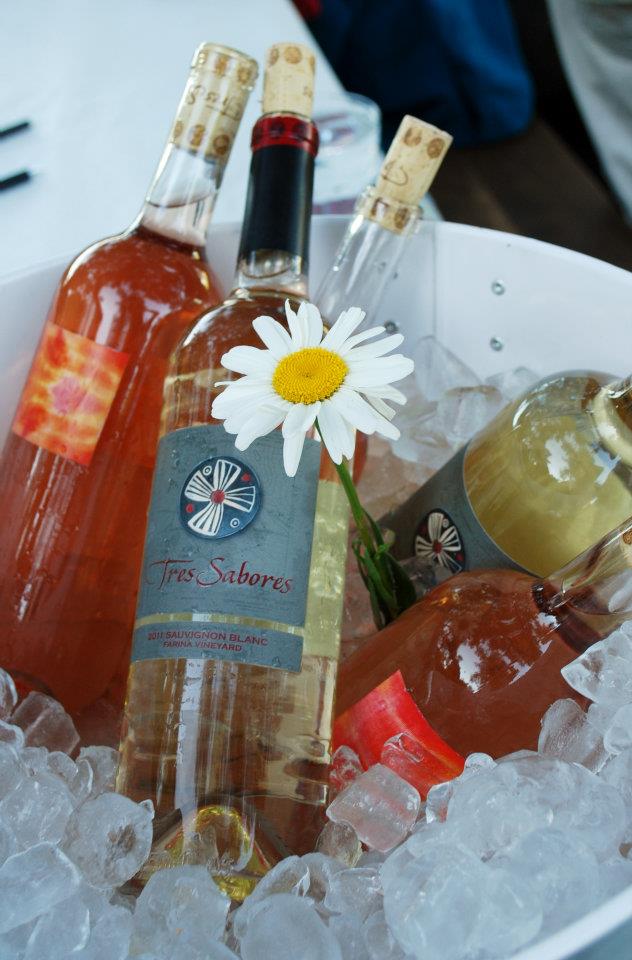 Speaking of experience and experiences, what have you seen in the past decades that has enthralled you in the industry ? On the other hand, what do you see as negative forces?
Speaking of experience and experiences, what have you seen in the past decades that has enthralled you in the industry ? On the other hand, what do you see as negative forces?
To the extent that people are more concerned about social justice and safety issues in the winery and the vineyards, we’ve made some progress. I do think that more people have come to the realization that it’s crucial to preserve our peripheral, native habitats, and prevent erosion (thus preserving the integrity and life of our soils and waterways). Some independent academic research is finally starting to happen in organic agriculture. New third party certified ag and winery programs like “Napa Green” have been developed and are educating growers and wineries about best practices (sponsored by the Napa Valley Vintners—I’m the chair of the NVV committee this year.)
Importantly, many more young women have entered the winemaking and viticultural fields—that’s really encouraging and wonderful! Finally, after years of accolades for high brix, high alcohol jammy style wines I think people are finally starting to understand the pleasures of a wine made with grace and finesse — the world of fine food has certainly made its way there.
Finally, where will Tres Sabores be in a few years? And what does Julie Johnson see as her future role?
My predictions:
My grapes will outlive me.
My kids will succeed in this business. (They’ve already joined it!)
I will have written (something) on my experience in the wine and grapegrowing business that talks ‘from the heart’.
Someone will discover a bottle of my wine hidden away in some closet or cellar, open it, and receive great pleasure from its contents!
Purchase Tres Sabores wines through their Online Store. When in Napa, contact the winery directly for appointments to tour and taste the wines.


